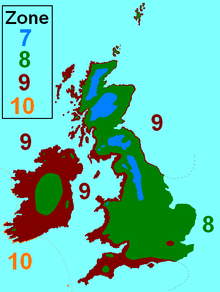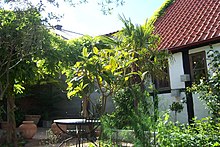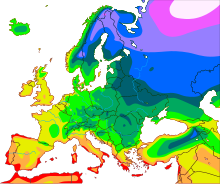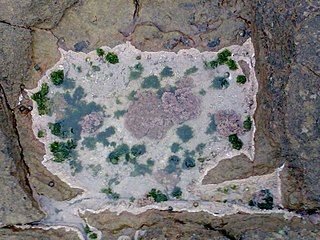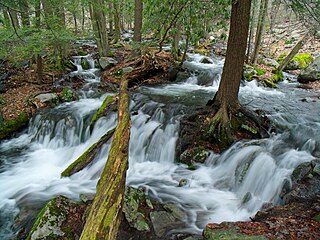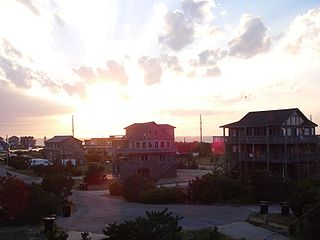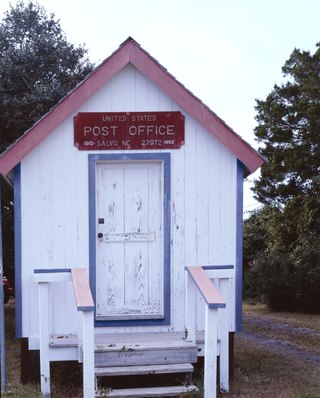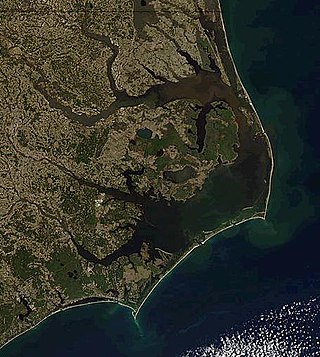United States hardiness zones (USDA scale)

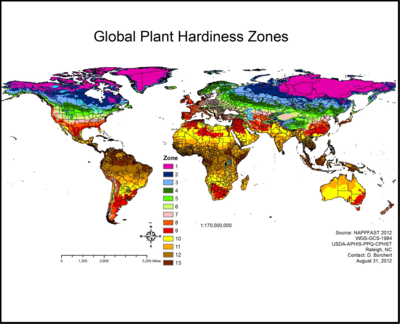
The USDA system was originally developed to aid gardeners and landscapers in the United States.
In the United States, most of the warmer zones (zones 9, 10, and 11) are located in the deep southern half of the country and on the southern coastal margins. Higher zones can be found in Hawaii (up to 12) and Puerto Rico (up to 13). The southern middle portion of the mainland and central coastal areas are in the middle zones (zones 8, 7, and 6). The far northern portion on the central interior of the mainland have some of the coldest zones (zones 5, 4, and small area of zone 3) and often have much less consistent range of temperatures in winter due to being more continental, especially further west with higher diurnal temperature variations, and thus the zone map has its limitations in these areas. Lower zones can be found in Alaska (down to 1). The low latitude and often stable weather in Florida, the Gulf Coast, and southern Arizona and California, are responsible for the rarity of episodes of severe cold relative to normal in those areas. The warmest zone in the 48 contiguous states is the Florida Keys (11b) and the coldest is in north-central Minnesota (2b). A couple of locations on the northern coast of Puerto Rico have the warmest hardiness zone in the United States at 13b. Conversely, isolated inland areas of Alaska have the coldest hardiness zone in the United States at 1a.
Definitions
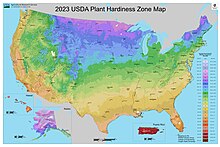
| Zone | From | To | |
|---|---|---|---|
| 0 | a | < −65 °F (−53.9 °C) | |
| b | −65 °F (−53.9 °C) | −60 °F (−51.1 °C) | |
| 1 | a | −60 °F (−51.1 °C) | −55 °F (−48.3 °C) |
| b | −55 °F (−48.3 °C) | −50 °F (−45.6 °C) | |
| 2 | a | −50 °F (−45.6 °C) | −45 °F (−42.8 °C) |
| b | −45 °F (−42.8 °C) | −40 °F (−40 °C) | |
| 3 | a | −40 °F (−40 °C) | −35 °F (−37.2 °C) |
| b | −35 °F (−37.2 °C) | −30 °F (−34.4 °C) | |
| 4 | a | −30 °F (−34.4 °C) | −25 °F (−31.7 °C) |
| b | −25 °F (−31.7 °C) | −20 °F (−28.9 °C) | |
| 5 | a | −20 °F (−28.9 °C) | −15 °F (−26.1 °C) |
| b | −15 °F (−26.1 °C) | −10 °F (−23.3 °C) | |
| 6 | a | −10 °F (−23.3 °C) | −5 °F (−20.6 °C) |
| b | −5 °F (−20.6 °C) | 0 °F (−17.8 °C) | |
| 7 | a | 0 °F (−17.8 °C) | 5 °F (−15 °C) |
| b | 5 °F (−15 °C) | 10 °F (−12.2 °C) | |
| 8 | a | 10 °F (−12.2 °C) | 15 °F (−9.4 °C) |
| b | 15 °F (−9.4 °C) | 20 °F (−6.7 °C) | |
| 9 | a | 20 °F (−6.7 °C) | 25 °F (−3.9 °C) |
| b | 25 °F (−3.9 °C) | 30 °F (−1.1 °C) | |
| 10 | a | 30 °F (−1.1 °C) | 35 °F (1.7 °C) |
| b | 35 °F (1.7 °C) | 40 °F (4.4 °C) | |
| 11 | a | 40 °F (4.4 °C) | 45 °F (7.2 °C) |
| b | 45 °F (7.2 °C) | 50 °F (10 °C) | |
| 12 | a | 50 °F (10 °C) | 55 °F (12.8 °C) |
| b | 55 °F (12.8 °C) | 60 °F (15.6 °C) | |
| 13 | a | 60 °F (15.6 °C) | 65 °F (18.3 °C) |
| b | > 65 °F (18.3 °C) | ||
History
The first attempts to create a geographical hardiness zone system were undertaken by two researchers at the Arnold Arboretum in Boston; the first was published in 1927 by Alfred Rehder, [1] and the second by Donald Wyman in 1938. [2] The Arnold map was subsequently updated in 1951, 1967, and finally 1971, but eventually fell out of use completely.
The modern USDA system began at the US National Arboretum in Washington. The first map was issued in 1960, and revised in 1965. It used uniform 10 °F (5.6 °C) ranges, and gradually became widespread among American gardeners. [3] [4]
The USDA map was revised and reissued in 1990 with freshly available climate data, this time with five-degree distinctions dividing each zone into new "a" and "b" subdivisions.
In 2003, the American Horticultural Society (AHS) produced a draft revised map, using temperature data collected from July 1986 to March 2002. The 2003 map placed many areas approximately a half-zone higher (warmer) than the USDA's 1990 map. Reviewers noted the map zones appeared to be closer to the original USDA 1960 map in its overall zone delineations. Their map purported to show finer detail, for example, reflecting urban heat islands by showing the downtown areas of several cities (e.g., Baltimore, Maryland; Washington, D.C., and Atlantic City, New Jersey) as a full zone warmer than outlying areas. The map excluded the detailed a/b half-zones introduced in the USDA's 1990 map, an omission widely criticized by horticulturists and gardeners due to the coarseness of the resulting map. The USDA rejected the AHS 2003 draft map and created its own map in an interactive computer format, which the American Horticultural Society now uses. [5]
In 2006, the Arbor Day Foundation released an update of U.S. hardiness zones, using mostly the same data as the AHS. It revised hardiness zones, reflecting generally warmer recent temperatures in many parts of the country, and appeared similar to the AHS 2003 draft. The Foundation also did away with the more detailed a/b half-zone delineations. [6]
In 2012 the USDA updated their plant hardiness map based on 1976–2005 weather data, using a longer period of data to smooth out year-to-year weather fluctuations. [7] Two new zones (12 and 13) were added to better define and improve information sharing on tropical and semitropical plants, they also appear on the maps of Hawaii and Puerto Rico. There is a very small spot east of San Juan, Puerto Rico, that includes the airport in coastal Carolina, where the mean minimum is 67 degrees F (19 C), which is classified as hardiness Zone 13b, the highest category, with temperatures rarely below 65 °F (18 °C). The map has a higher resolution than previous editions, and is able to show local variations due to factors such as elevation or large bodies of water. Many zone boundaries were changed as a result of the more recent data, as well as new mapping methods and additional information gathered. Many areas were a half-zone warmer than the previous 1990 map. [8] The 2012 map was created digitally for the internet, and includes a ZIP Code zone finder and an interactive map. [9] [10]
In 2015, the Arbor Day Foundation revised another map, also with no a and b subdivisions, showing many areas having zones even warmer, with the most notable changes in the Mid Atlantic and Northeast, showing cities like Philadelphia, New York City and Washington D.C. in zone 8, due to their urban heat islands. [11]
In November 2023, the USDA released another updated version of their plant hardiness map, based on 1991–2020 weather data across the United States. The updated map shows continued northward movement of hardiness zones, reflecting a continued warming trend in the United States' climate. [12]
Selected U.S. cities
The USDA plant hardiness zones for selected U.S. cities as based on the 2023 map are the following:
Limitations
As the USDA system is based entirely on average annual extreme minimum temperature in an area, it is limited in its ability to describe the climatic conditions a gardener may have to account for in a particular area: there are many other factors that determine whether or not a given plant can survive in a given zone.
Zone information alone is often not adequate for predicting winter survival, since factors such as frost dates and frequency of snow cover can vary widely between regions. Even the extreme minimum itself may not be useful when comparing regions in widely different climate zones. As an extreme example, due to the Gulf stream most of the United Kingdom is in zones 8–9, while in the US, zones 8–9 include regions such as the subtropical coastal areas of the southeastern US and Mojave and Chihuahuan inland deserts, thus an American gardener in such an area may only have to plan for several nights of cold temperatures per year, while their British counterpart may have to plan for several months.
In addition, the zones do not incorporate any information about duration of cold temperatures, summer temperatures, or sun intensity insolation; thus sites which may have the same mean winter minima on the few coldest nights and be in the same garden zone, but have markedly different climates. For example, zone 8 covers coastal, high latitude, cool summer locations like Seattle and London, as well as lower latitude, hot-summer climates like Charleston and Madrid. Farmers, gardeners, and landscapers in the former two must plan for entirely different growing conditions from those in the latter, in terms of length of hot weather and sun intensity. Coastal Ireland and central Florida are both Zone 10, but have radically different climates.
The hardiness scales do not take into account the reliability of snow cover in the colder zones. Snow acts as an insulator against extreme cold, protecting the root system of hibernating plants. If the snow cover is reliable, the actual temperature to which the roots are exposed will not be as low as the hardiness zone number would indicate. As an example, Quebec City in Canada is located in zone 4, but can rely on a significant snow cover every year, making it possible to cultivate plants normally rated for zones 5 or 6. But, in Montreal, located to the southwest in zone 5, it is sometimes difficult to cultivate plants adapted to the zone because of the unreliable snow cover.[ citation needed ]
Many plants may survive in a locality but will not flower if the day length is insufficient or if they require vernalization (a particular duration of low temperature).
There are many other climate parameters that a farmer, gardener, or landscaper may need to take into account as well, such as humidity, precipitation, storms, rainy-dry cycles or monsoons, and site considerations such as soil type, soil drainage and water retention, water table, tilt towards or away from the sun, natural or manmade protection from excessive sun, snow, frost, and wind, etc. The annual extreme minimum temperature is a useful indicator, but ultimately only one factor among many for plant growth and survival. [9] [3] [32]
Alternatives
An alternative means of describing plant hardiness is to use "indicator plants". In this method, common plants with known limits to their range are used.[ citation needed ]
Sunset publishes a series that breaks up climate zones more finely than the USDA zones, identifying 45 distinct zones in the US, incorporating ranges of temperatures in all seasons, precipitation, wind patterns, elevation, and length and structure of the growing season. [33]
In addition, the Köppen climate classification system can be used as a more general guide to growing conditions when considering large areas of the Earth's surface or attempting to make comparisons between different continents. [34] The Trewartha climate classification is often a good "real world" concept of climates and their relation to plants and their average growing conditions.[ citation needed ]
